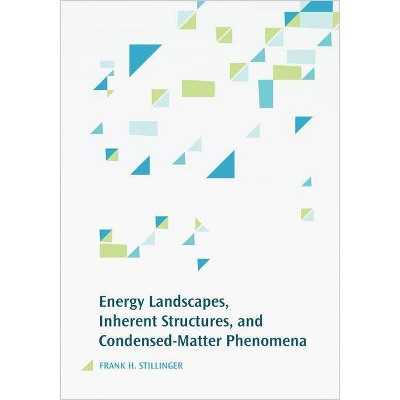Energy Landscapes, Inherent Structures, and Condensed-Matter Phenomena - by Frank H Stillinger (Hardcover)

Similar Products
Products of same category from the store
AllProduct info
<p/><br></br><p><b> Book Synopsis </b></p></br></br><p>This book presents an authoritative and in-depth treatment of potential energy landscape theory, a powerful analytical approach to describing the atomic and molecular interactions in condensed-matter phenomena. Drawing on the latest developments in the computational modeling of many-body systems, Frank Stillinger applies this approach to a diverse range of substances and systems, including crystals, liquids, glasses and other amorphous solids, polymers, and solvent-suspended biomolecules. <p/>Stillinger focuses on the topography of the multidimensional potential energy hypersurface created when a large number of atoms or molecules simultaneously interact with one another. He explains how the complex landscape topography separates uniquely into individual basins, each containing a local potential energy minimum or inherent structure, and he shows how to identify interbasin transition states--saddle points--that reside in shared basin boundaries. Stillinger describes how inherent structures and their basins can be classified and enumerated by depth, curvatures, and other attributes, and how those enumerations lead logically from vastly complicated multidimensional landscapes to properties observed in the real three-dimensional world. <p/>Essential for practitioners and students across a variety of fields, the book illustrates how this approach applies equally to systems whose nuclear motions are intrinsically quantum mechanical or classical, and provides novel strategies for numerical simulation computations directed toward diverse condensed-matter systems.</p><p/><br></br><p><b> From the Back Cover </b></p></br></br><p>"Remarkably comprehensive, clearly presented, and rich with examples. The scope of topics is encyclopedic, taking readers from broad classes to paradigmatic specifics such as helium and water. The book is quite different from and complementary to David Wales's book, <i>Energy Landscapes</i>."<b>--R. Stephen Berry, University of Chicago</b></p><p>"This is an extraordinary book, remarkable for its breadth of coverage, depth of physical insight, clarity, and technical rigor. Invoking the energy landscape viewpoint as an overarching and unifying theme, Stillinger takes the reader on a fascinating journey whose ports of call include crystals, liquids, glasses, clusters, helium, polymers, and that most ubiquitous and intriguing of substances, water. A masterful panorama of condensed-matter physics and chemistry as viewed through the lens of the inherent structure formalism, presented by one of the subject's acknowledged masters."<b>--Pablo G. Debenedetti, Princeton University</b></p><p>"Stillinger has produced the most readable of all books on the subject, equally suitable for a course in chemistry or physics. It is also ideal for self-study by practitioners who want to better understand some of the more complex ideas that characterize current work in this area."<b>--H. Eugene Stanley, Boston University</b></p><p>"Stillinger provides a formalism for describing energy landscapes along with many examples of how this formalism may be used to understand the energetics of condensed-matter phenomena. His presentation will be of significant value to junior scientists, including beginning graduate students, as well as senior researchers. The book is a pleasure to read, with many interesting insights and discussions."<b>--Paul Whitford, Northeastern University</b></p><p/><br></br><p><b> Review Quotes </b></p></br></br><br>"Remarkably comprehensive, clearly presented, and rich with examples. The scope of topics is encyclopedic, taking readers from broad classes to paradigmatic specifics such as helium and water. The book is quite different from and complementary to David Wales's book, <i>Energy Landscapes</i>."<b>--R. Stephen Berry, University of Chicago</b><br><br>"Stillinger has produced the most readable of all books on the subject, equally suitable for a course in chemistry or physics. It is also ideal for self-study by practitioners who want to better understand some of the more complex ideas that characterize current work in this area."<b>--H. Eugene Stanley, Boston University</b><br><br>"Stillinger provides a formalism for describing energy landscapes along with many examples of how this formalism may be used to understand the energetics of condensed-matter phenomena. His presentation will be of significant value to junior scientists, including beginning graduate students, as well as senior researchers. The book is a pleasure to read, with many interesting insights and discussions."<b>--Paul Whitford, Northeastern University</b><br><br>"This is an extraordinary book, remarkable for its breadth of coverage, depth of physical insight, clarity, and technical rigor. Invoking the energy landscape viewpoint as an overarching and unifying theme, Stillinger takes the reader on a fascinating journey whose ports of call include crystals, liquids, glasses, clusters, helium, polymers, and that most ubiquitous and intriguing of substances, water. A masterful panorama of condensed-matter physics and chemistry as viewed through the lens of the inherent structure formalism, presented by one of the subject's acknowledged masters."<b>--Pablo G. Debenedetti, Princeton University</b><br><p/><br></br><p><b> About the Author </b></p></br></br><b>Frank H. Stillinger</b> is senior scientist in the Department of Chemistry at Princeton University. He is a member of the National Academy of Sciences.
Price History
Cheapest price in the interval: 99.5 on November 8, 2021
Most expensive price in the interval: 99.5 on December 20, 2021
Price Archive shows prices from various stores, lets you see history and find the cheapest. There is no actual sale on the website. For all support, inquiry and suggestion messagescommunication@pricearchive.us




















